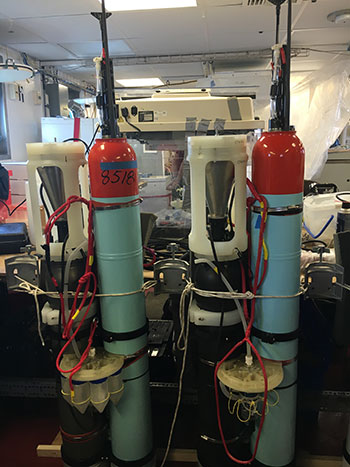The National Science Foundation (NSF) funded this research voyage to better understand the global carbon cycle through robotic monitoring of the ocean’s biological carbon pump.

Chart showing the path of the research cruise aboard the Oceanus. The first station, labeled SCB, is the Santa Cruz Basin, a site that reflects near coast conditions. Station 2, located about 350 miles offshore, is a nutrient-poor zone. (Image: Google Earth)
The biological carbon pump plays a key role in the global carbon cycle. The process starts with marine photosynthetic organisms near the ocean’s surface and ends in particles that settle on the sea floor. Unlike terrestrial vegetation, marine photosynthesizers only live a week before they are consumed.
Estimates indicate that half of the photosynthesis on Earth takes place in the oceans. As much as 10 petagrams of carbon per year are processed via this pump (1 petagram is equal to 1 trillion kilograms).
Despite this, studying the factors that regulate the ocean’s biological carbon pump has been hampered by the limited ability to observe the process over space and time. Biogeochemist Jim Bishop, a faculty senior scientist at Berkeley Lab’s Earth and Environmental Sciences Area and a professor at UC Berkeley’s Department of Earth and Planetary Science showed just how uncertain current estimates are of the biological carbon pump’s strength. Bishop and colleagues published a May 2016 study in the journal Biogeosciences that found that the strength of carbon export off the coast of California is likely underestimated by at least a factor of 3 to 20.
What is needed, says Bishop, is robotic technology that can provide ongoing measurements of these ocean processes over periods of months to a year. Working with engineers at Berkeley Lab, Bishop developed the Carbon Flux Explorers, ocean-profiling robots that began as a Department of Energy project. Their accelerated development began in 2010 with NSF support.
To demonstrate that the robots are able to measure the strength of carbon sedimentation in the ocean, Bishop and his research team added sample collection systems to two Carbon Flux Explorers through projects funded by the NSF called Carbon Sedimentation iN the Ocean Watercolumn: Calibration (C-SNOW, Award #1538686) and Sensor for Particulate Inorganic Carbon (Award #0964888).
The researchers will be tasked with calibrating the three types of optical readings obtained through the robots’ built-in cameras with the actual amount of particulate organic carbon, particulate inorganic carbon (also known as calcium carbonate), and other biogenic particles collected at the time.
Data from the two modified Carbon Flux Explorers (called CFE-Cal), will be compared with readings obtained from other monitoring equipment, including two other Carbon Flux Explorers and surface tethered Optical Sedimentation Recorders. Samples will be taken from California coastal and offshore waters.
The goal will be to demonstrate the ability of the Carbon Flux Explorer to measure the strength of carbon sedimentation in the ocean in a way that is currently impractical and cost-prohibitive to do through research voyages alone. And with larger deployments of these robots, Bishop hopes to obtain information that will ultimately feed into and improve climate change models.

